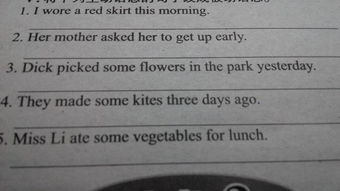主动语态转化为被动语态的方法(主动语态变被动语态的方法)
1.主动语态变被动语态的方法
英语中及物动词有两种语态,即主动语态和被动语态。
主动语态表示主语是动作的执行者被动语态表示主语是动作的承受者。被动语态由“助动词be+及物动词的过去分词”构成。
助动词be有人称、时态和数的变化。 一、被动语态的用法: 1. 一般现在时的被动语态构成:is / am / are + 及物动词的过去分词 Our classroom is cleaned everyday. I am asked to study hard. Knives are used for cutting things. 2. 一般过去时的被动语态构成:was / were + 及物动词的过去分词 A new shop was built last year. Dinosaur eggs were laid long long ago. 3. 现在完成时的被动语态构成:has / have + been + 及物动词的过去分词 This book has been translated into many languages. Many man-made satellites have been sent up into space by many countries. 4. 一般将来时的被动语态构成:will+ be + 及物动词的过去分词 A new hospital will be built in our city. Many more trees will be planted next year. 5. 含有情态动词的被动语态构成:情态动词+ be + 及物动词的过去分词 Young trees must be watered often. Your mistakes should be corrected right now. The door may be locked inside. Your homework can be handed in tomorrow. 6. 现在进行时的被动语态构成:am / is / are + being + 及物动词的过去分词 Uncle Wang is mending my bike now.→ My bike is being repaired by Tom now. They are planting trees over there. → Trees are being planted over there by them. 7. 不定式的被动语态:to + be + 及物动词的过去分词 There are two books to be read. → There are twenty more trees to be planted. 二、怎样把主动语态改成被动语态? 把主动语态改为被动语态非常简单,可以遵循以下几个步骤: 1. 先找出谓语动词; 2. 再找出谓语动词后的宾语; 3. 把宾语用作被动语态中的主语; 4. 注意人称、时态和数的变化。
例:1. Bruce writes a letter every week. →A letter is written by Bruce every week. 2. Li Lei mended the broken bike this morning.→The broken bike was mended by Li Lei this morning. 3. He has written two novels so far.→Two novels have been written by him so far. 4. They will plant ten trees tomorrow.→Ten trees will be planted by them tomorrow. 5. Lucy is writing a letter now.→A letter is being written by Lucy now. 6. You must lock the door when you leave.→the door must be locked when you leave. 三、使用被动语态应注意的几个问题: 1. 不及物动词无被动语态。 What will happen in 100 years. The dinosaurs disappeared about 65 million years ago. 2. 有些动词用主动形式表示被动意义。
This pen writes well. This new book sells well. 3. 感官动词或使役动词使用省略to的动词不定式,主动语态中不带to ,但变为被动语态时,须加上to 。 例:make somebody do something→somebody+ be +made to do something see somebody do something→somebody +be +seen to do something A girl saw my wallet drop when she passed by.→My wallet was seen to drop by a girl when she passed by. The boss made the little boy do heavy work.→The little boy was made to do heavy work by the boss. 4. 如果是接双宾语的动词改为被动语态时,直接宾语(物)作主语,那么动词后要用介词,这个介词是由与其搭配的动词决定。
He gave me a book.→A book was given to me by him. He showed me a ticket.→A ticket was shown to me by him. My father bought me a new bike. →A new bike was bought for me by my father. 5. 一些动词短语用于被动语态时,动词短语应当看作一个整体,而不能丢掉其中的介词或副词。 We can't laugh him. →He can't be laugh by us. He listens to the radio every day. →The radio is listened to by him every day. The nurse is taking care of the sick man. →The sick man is being taken care of by the nurse.。
2.怎么把主动语态变成被动语态
主动语态变为被动语态的方法
将主动语态变为被动语态的方法可分为三步:
第一步是把主动句的宾语变成被动句的主语;
第二步是把主动句的谓语变成“be+过去分词”,be时态要与原句保持一致;
第三步是把主动句的主语变为by的宾语,放在被动句的谓语之后,by短语可以省略。
如:
Mary broke the cup. 玛丽打破了杯子。
The cup was broken by Mary. 杯子是玛丽打破的。
扩展资料:
被动语态的口诀:
一般现在时、一般过去时用be +及物动词的.过去分词,be有人称、时、数变。
完成时态have(has)done,被动将been加中间。
一般将来shall(will)do,被动变do为be done。
将来进行无被动,shall(will)be doing。
现在完成时,被动 have(has)been done。
现、过进行be doing,被动be加being done。
情、助、有、是妥安排,一律随新主语变。
否定助后加not,疑问一助置主前。
主语恰是疑问词,直陈语序主在前。
一般情助加be done,双宾多将间宾变。
复合宾语宾变主,宾补、主补相应变。
3.主动语态如何改成被动语态
去百度文库,查看完整内容>
内容来自用户:恬淡虚无
如何把主动语态转换为被动语态
语态是动词的一种形式,用来说明主语和谓语动词之间的关系。其中主动语态表示主语执行动作,被动语态表示主语承受动作。那么,怎样把主动语态转换为被动语态呢?
1.先确定主动句的主、谓、宾,找出其谓语动词;
2.把主动句中谓语动词后面的宾语变为被动句的主语,若宾语是人称代词时,应把宾格变为主格;
3.把主动句中的谓语动词变为“助动词be +及物动词的过去分词”结构,但时态不能改变;
4.把主动句中谓语动词前面的主语变为被动句中介词by的宾语(没必要说出动作的执行者时可略去“by +宾语”),若主语是人称代词时,应把主格变为宾格。友情提示:
1.如果主动语态中含有动词短语变为被动语态时,不可丢掉短语末尾的介词或副词。如:
You can look up this word in the dictionary.→This word can be looked up in the dictionary.
2.使役动词make, have及感官动词see, hear, watch, feel等后接省略to的不定式作宾语补足语的主动语态变为被动语态时,动词不定式的符号to还要加上去。如:
The boss made them work for 16 hours a day.→They were made to work for 16 hours a day (by the boss).
We saw them work in that workshop.→They were seen to work (by us) in that workshop.
3.如果主动语态的句子中含有双宾语变为被动语态时,有两种方法:①将指人的间接宾语作被动语态的主语时,要将人称代词宾格变为人称
4.怎样将主动语态改为被动语态
英语动词有两种语态:主动语态和被动语态。
主动语态表示主语是动作的执行者,被动语态表示主语是动作的承受者。如: Many people speak English.(主动语态) English is spoken by many people.(被动语态) 1.被动语态的构成 由于不及物动词不能带宾语,故无被动语态,只有及物动词或相当于及物动词的动词短语才有被动语态,其基本构成方式是“助动词be+过去分词”。
注意:“be+过去分词”结构不一定都是被动语态,有些动词(如 be,feel,look,seem等)后面的过去分词已转化为形容词,用作表语表示状态。如: My bike is broken.(我的自行车坏了。)
The door is open.(门开了。) 2.主动语态改被动语态的方法 1)将主动语态改为被动语态应注意以下三个方面:①将主动语态的宾语改为被动语态的主语;②将主动语态的谓语动词改为“be+过去分词”结构;③将主动语态的主语改为介词by之后的宾语,放在谓语动词之后(有时可省略)。
2)含直接宾语和间接宾语的主动语态改为被动语态时有两种情况:①把间接宾语改为被动语态的主语,直接宾语仍保留原位;②把直接宾语改为主动语态的主语,此时,间接宾语前要加介词to或 for。如: He gave the boy an apple.→The boy was given an apple.(或An apple was given to the boy.) Her father bought her a present.→She was bought a present by her father.(或A present was bought for her by her father.) 3)不带to的动词不定式作宾语补足语的主动语态,改为被动语态时不定式前要加to。
如: They watched the children sing that morning.→The children were watched to sing that morning. 4)带复合宾语的动词在改为被动语态时,一般把主动语态的宾语改为主语,宾语补足语在被动语态中作主语补足语。如: We call him Xiao Wang.→He is called Xiao Wang. He cut his hair short.→His hair was cut short. They told him to help me.→He was told to help me. 5)短语动词是不可分割的整体,改为被动语态时要保持其完整性,介词或副词不可遗漏。
如: We must take good care of the young trees.→The young trees must be taken good care of. 6)含有宾语从句的主动结构变为被动结构时,通常用it作为被动结构的先行主语,从句放在句子后面;也可采用另一种形式。可以这样转换为被动结构的动词有know,say,believe,find,think,report等。
如: People believe that he is ill.→It is believed that he is ill.(或:He is believed to be ill.) 3.被动语态改为主动语态的方法: 被动语态中介词by后的宾语改为主动语态中的主语(或按题意要求确定主语),按照这个主语的人称和数以及原来的时态把谓语动词形式由被动语态改为主动语态。注意在主动语态中有的动词要求不带to的动词不定式作宾语补足语,此时要把被动语态中的to去掉。
被动语态的主语用来作主动语态的宾语。如: History is made by the people.The people make history. 4.不能用于被动语态的情况 1)某些表示“静态”的及物动词(表示状态而不是动作,而且常常是不可用于进行时态的动词)如have,fit,suit,hold(容纳),cost, suffer,last(持续)等不能用于被动语态。
如: They have a nice car.他们有一辆漂亮的汽车。 My shoes don't fit me.我的鞋不合适。
My brain can't hold so much information at one time.我的脑子一下子记不住这么多资料。 How much /What does it cost?这值多少钱? Our holiday lasts 10days.我们的假期有十天。
This food will last(them)(for)3days.这食物足够(他们)(吃)三天。 2)不是所有带介词的动词都能用于被动结构。
若是构成成语动词通常有被动态,若不构成成语动词则无被动态。试比较: They arrived at a decision.A decision was arrived at.他们作出了决定。
They arrived at the station.他们到达车站。(不说:The station was arrived at.) He looked into the question.The question was looked into.他调查了这个问题。
3)动词leave(离开),enter(进入),join(参加)不可用于被动语态。如: The car left the road and hit a tree.车子离开了道路,撞上了树。
4)某些及物动词可作不及物动词用,特别是后加副词(如well, easily等)时。主动语态有被动含义,这类动词常见的有sell,write, wear,wash,cook,open,close,lock,read,record等。
如: His new novel is selling well.他的新小说很畅销。The cloth washes well.这布很耐洗。
This material won't wear.这种材料不耐穿。His play won't act.他的戏剧不会上演。
The window won't shut.这窗关不上。The door won't open.这门打不开。
The door won't lock.这门锁不上。This poem reads well.这首诗读来很好。
5)feel,look,appear,sound,taste,smell等由实意动词演变而来的系动词,后接形容词作表语,不可用于被动语态。如: Tell me if you feel cold.你要是感到冷就告诉我。
You're looking very unhappy—what's the matter?你看来很不高兴———怎么回事儿? The soup tastes wonderful.这汤味道好极了。 Those roses smell beautiful.那些玫瑰好闻极了。
She appears to be friendly.她看上去很友好。 6)宾语是不定式或动词的-。
5.主动语态变被动语态 那三步啊
把主动语态变为被动语态时,应走好以下三步:
1)主动语态的宾语变为被动语态的主语;
2)主动语态的谓语动词由主动语态形式变为被动语态形式;
3)主动结构的主语变为介词by的宾语,组成介词短语,放在被动结构的谓语动词之后。(在无须说明动作的执行者或只强调动作的承受者时,by短语可以省略。)
请看示范:
主动语态:My brother repaired that bike yesterday.
主语 谓语动词 宾语其余部分
被动语态:That bike was repaired (by my brother) yesterday.
主语 谓语动词 by+宾语其余部分
对于主动语态变为被动语态方法的考查,主要在句型转换题目中出现。只要能够按照上面介绍的方法去做,一般是能够做对的。
6.主动语态变被动语态 方法 要自己总结的
将主动句的主语、宾语分别做被动句的宾语、主语,就是相互交换一下,这是最简单的,有时主、宾语是瘾藏的,变的时候需要跟具意思找出它们,再进行变换;这是变的规则:一般现在、过去时,is(are)/was(were)+过去分词;一般现在、过去进行时,is(are)/was(were)+being+过去分词;现在、过去完成时,has(have)/had+been+过去分词;一般将来时,will+be+过去分词;情态动词,can(may/might/ought/)+be+过去分词;。

相关推荐
声明:本网站尊重并保护知识产权,根据《信息网络传播权保护条例》,如果我们转载的作品侵犯了您的权利,请在一个月内通知我们,我们会及时删除。
蜀ICP备2020033479号-4 Copyright © 2016 学习鸟. 页面生成时间:3.032秒









